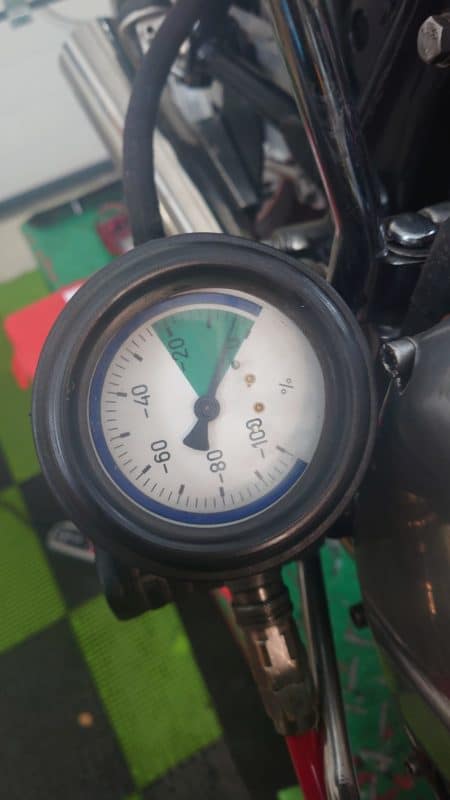With age come the flaws. And 'maintenance is preservation'. Those kinds of things come together at the small, non-brand or importer-related motorcycle shops. This concerns, for example, RG Tuning from Apeldoorn, a company that maintains its position in the budget segment of motorcycling with sales. But father and son are mainly good technicians. The owner of a 1000 Kawasaki Z1A1977 knew this too. The engine didn't start properly and when it ran it was sneezing and protesting, but little of the festiveness for which these blocks are famous.
Unscrewing everything from everything gives a good feeling, but is not very focused. First, a diagnosis process must be completed. So first a compression and a leak test is done.
What is the difference?
You measure compression with a compression meter, remove the spark plug, turn the nipple in the spark plug hole and connect the meter to it. Then you pull the carburettors loose (or open the throttle full) and press the start button. Then you see that the meter gives a value, in this case it is between 8,2 and 9 bar. That's not the compression ratio, it's the compression pressure. The leak test looks a bit like it. The start is the same: Also a nipple in the spark plug hole. Valves closed and piston exactly at top dead center. With a special meter you pump between 7 and 8 bar in the cylinder. The meter shows a value and that is percentage of leak. The great thing is, if you have a leak, you can now also hear where the leak is:
Blowing out the exhaust means that the exhaust valve does not close, from the intake the intake valve is leaking and air from the crankcase ventilation there is a leak along the piston.
'Mistake! Thank you!
With a compression test you only measure whether or not you have enough pressure, the leak test immediately gives an indication where to look. This old Z1000 is otherwise fine, has about 4 to 7% leak, and that's neat. It can also happen that the leak test is excellent, while the compression is different. That happened a while back with a BMW R1100S. That boxer turned out to have an original piston on the left and a piston from an R1100GS on the right. The GS piston has a lower compression pressure than the 1100S. That's why the engine rocked a bit more at idle than normal.
There was a time when this test equipment was expensive and high tech
Now every serious company that deals with (older) motorcycles should have such a thing. And even for us self-toolers, this kind of tool is affordable. But keep in mind two things: Not everything that comes from China is equally good. And even good tools are only as good as the man who uses them.








Old Guzzi V7 also ran with half piston rings (segment in Flemish). To Le Mans and back, or complete tour of Switzerland. Without power you don't need compression. Consumption 4l/100. How beautiful simplicity can be. Old thing kept because I'm in love with it, old women without botox or liftings are also more beautiful, right?
Nice piece again. I don't quite agree with the way to measure leaks. How are you going to block a piston in the top position with about 10 bar compressed air? Moreover: it is not only the piston rings but also the slideway in the cylinder that wears out. This is the distance traveled from combustion TDC to ODP, in which the connecting rod makes the largest angle opposite to that cylinder wall half. The TDC part often contains carbon deposits, which also ensures sealing. I think it would be fantastic to turn your hobby into a profession and an honor to turn the discarded or almost written-off stuff into a nice driving thing again. Once again a nice article!
And what comes from China = pollution by definition. Also for our own economy
Oh.
Tools don't have to be expensive.
Good tools sometimes / often are.
I think it depends on how often you use something.
If you are working on it on a daily basis, then it must be better / more durable / more ergonomic than once on a Saturday.
And if it doesn't work, we always say: “a bad mechanic blames his tools”. . . .. 🙂
Strong text!